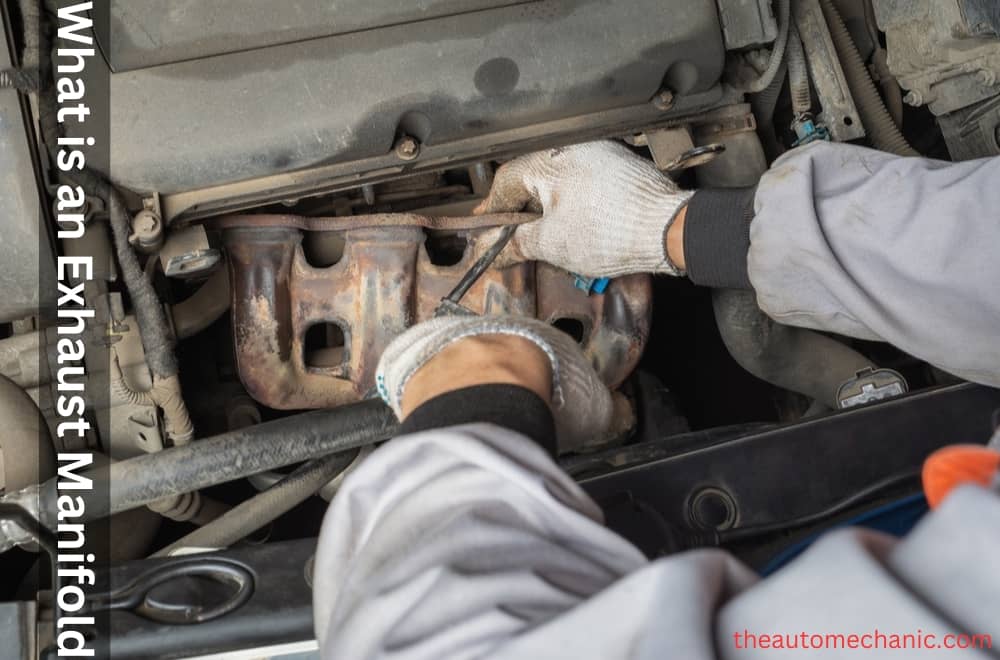Although the manifold system is very helpful, it can cause leaks. We will explain how you can discover and act upon these leaks early. Before then, we want to answer this question: what is an exhaust manifold? Read our answer below.
What is an exhaust manifold?
“Some people call it an exhaust pipe. Regardless of how you call it, a manifold is a system of several parts”.
A manifold is the section closest to the engine. It directly collects hot gases from the engine, making it prone to damage. Before these gases escape into the air, they pass through all the other parts for cooling and cleansing.
Exposure to hot gases causes the exhaust system to wear down faster than other auto parts, so you might have to replace it more often. Most auto manufacturers make manifolds from cast iron or stamped steel, which can withstand harsh temperatures. Regardless, they will start to leak at some point, so it is vital to know how to tell if the exhaust manifold is leaking.
Engine gases are toxic and dangerous. If the exhaust has holes, engine gases could leak into the car cabin instead of entering the atmosphere. Besides risking your life, exhaust leaks could largely affect your auto performance.
How does an exhaust manifold work?
An exhaust manifold controls engine noises by cooling, cleansing, and removing gases from the combustion chamber. This burdensome task requires the help of other components, including oxygen sensors, heat shields, a resonator, a muffler, tailpipes, and a catalytic converter.
Exhaust systems can get very hot. Still, the hottest they should ever get is about 1,800 degrees F or 850 degrees C. When the manifold receives hot gases from the combustion system, it directs them to other areas via its cylinders. As it does so, an oxygen sensor near it tests the amount of oxygen in the fumes. A chemical reaction takes place when the hot fumes enter the catalytic converter.
When leaving this area, the gases have reduced toxicity. As they leave the catalytic converter, the fumes find another oxygen sensor that measures the oxygen levels. The less poisonous gases travel through the resonator for sound control and reduction. From here, they enter the muffler, a chambered part that alters exhaust noises.
Finally, the component that exits fumes into the atmosphere is the tailpipe. The pipe removes smoke at the rear side of the auto.
What causes an exhaust manifold to leak?
Before we discuss how to tell if the exhaust manifold is leaking, let us disclose the causes of the leakage. The main causes are:
- A spoilt manifold gasket – As earlier hinted, the exhaust manifold system receives very hot fumes. When the car stops moving, the exhaust cools down fast. Due to sudden expansion and contraction, the exhaust gasket can develop cracks and holes. These dents can then prevent the gasket from sealing the entire exhaust system. Without the seal, the muffler and resonator cannot control engine noises. That is why a vehicle with spoilt exhaust manifolds has an annoying and weird noise.
- Manifold’s cracks – We mentioned that the manifold is the component closest to the engine. Even if it is a cast iron or stamped steel piece of metal, the manifold can develop cracks over time. Expansion and cooling cycles of the exhaust system might trigger these cracks. Even the tiniest crack in this area can trigger weird exhaust noises when you ignite the engine. It is harder to notice this when you drive away. But as the crack gets bigger, no amount of metal expansion can seal it.
- Loose or defective manifold bolts—Leaks can exist even if an exhaust manifold has no cracks. Manifold bolts can become faulty or loose due to nonstop heating and cooling cycles. In addition, these bolts can become old and worn out. After loosening or wearing down, the bolts can cause holes, which can allow gases and noises to escape.
Besides these causes, the combustion process might release water as an end product during winter. Water can make the exhaust system rust and develop holes over time. In addition, the exhaust system’s positioning makes it prone to all bad weather conditions. As a result, it gradually wears down until there are some leaks.
How to tell if the exhaust system is leaking?
What is an exhaust manifold? If someone asks you this question, you can now answer them. Also, we listed the causes of the leaks. Now, we want to reveal the symptoms of a leaking manifold. These include the following:
- Weird engine noises—Have your engine noises changed these days? Before you learn how to fix an exhaust manifold leak, make sure there is one. One sign is a strange noise as hot smoke escapes from within the system. Not only is the sound different, but it is also loud and disturbing.
- Decreased fuel economy—Your engine was consuming less fuel, but suddenly, it needed more fuel for the same number of miles. If that is the case, an exhaust leak might need repair.
- Weird odors—Exhaust fumes do not smell good naturally. But if you notice severe carbon monoxide smells, the manifold could leak.
- Less acceleration power—A powerless engine can make it harder for your car to accelerate and slow down. The cause of less engine power is a leak in the exhaust manifold. Have the manifold checked and repaired as soon as you notice a lack of sufficient engine power.
- The engine light has turned on. A car has many sensors that relay messages to the engine computer when they sense an issue. If that happens, the engine light turns on. If the engine has no problem, inspect the exhaust system. There might be a leak.
- Damaged bolts – We talked about spoilt or loose bolts earlier. The holes they leave behind might cause exhaust leaks. Inspect the manifold to see if it has twisted and forced the bolts to overextend and crack. The bolts could also be loose.
Once you notice these symptoms, try to learn how to fix an exhaust manifold leak. Inspect the exhaust manifold closely to identify the parts that require replacement. In addition, study the market to determine how much to replace it.
“Before you inspect the exhaust system, let the car cool down. Then, wear safety gloves because you will come across heat, soot, and rust”.
What does a manifold leak sound like?
Inspecting the leaks is perfect. To be sure there are leaks, listen to the engine noises. When the manifold system has leaks, it will produce tapping sounds. After you start the engine, the tapping noise will abound.
That might be the best time to inspect the system for leaks. If you notice leaks and do nothing, the following might happen:
- Engine fumes will flow in a reverse direction and pollute the car interiors.
- A damaged exhaust manifold will affect the performance of oxygen sensors
- Your vehicle will consume more fuel
- Exhaust valves and the EGR valve might malfunction
- The catalytic converter may fail, which may lead to the emission of toxic gases.
How to fix an exhaust manifold leak?
Before repairing a manifold leak, you must spot it first. Other parts may leak and cause symptoms similar to those of a leaky exhaust system. Remove the exhaust system to examine it closely. After being sure there is a leak, find ways to repair it.
Repairing it yourself
A severely damaged exhaust manifold may require immediate replacement. Otherwise, you might only have to replace the damaged component. So, decide whether to repair the exhaust or hire someone to do the job.
The parts that most often succumb to damage are the manifold gasket, manifold bolts or studs, or the manifold itself. Note that you can still drive a car with a damaged exhaust pipe.
Nevertheless, driving it that way will only worsen the problem and cause other mechanical parts to fail. If you have the confidence, you will need the following tools:
- New spare parts. We assume that you already know the damaged part. So, you might have the whole exhaust system, bolts, or manifold gasket.
- Spanners, ratchet, and socket set
- Your jack and its stand
- Safety gloves
- Towels
- Torque spanners
- Penetrating oil and degreaser
- Your vehicle manual.
Repairing the exhaust manifold yourself can be challenging. If you are willing to try, start by preparing your auto. Drive your car to a flat surface, such as your garage. Wait until the car exhaust cools down. Detach the negative cable of your battery. Jack up the car and let it rest on the jack stand.
Next, consult the car manual to know how to repair manifold leaks. Assuming you know where the leaks are, wear your safety gloves and remove the exhaust manifold bolts. Two big bolts attach the manifold to the rest of the exhaust system. Depending on your exhaust system’s design, these bolts may be hard to find.
You might have to check beneath the heat shields. Use your spanner or wrench to untie them. If they feel too tight, pour some penetrating manifold oil on them and leave them for fifteen minutes. The lubrication will allow the bolts to come out smoothly.
If the gasket has leaks, do not remove the manifold from the engine area. Instead, pull it out halfway and remove the damaged gasket from the manifold cylinder. Place the new manifold gasket into the slot the older one had occupied.
If the whole manifold has cracks, you must pull it out completely. Next, insert the new manifold the way you removed the older one. The manual will guide you through the process.
Check how much to replace the manifold exhaust.
As a busy professional, you may not have the time for the simple DIY task explained above. Again, you may have the time but not the confidence to do a thorough job. In each case, you can consult a professional mechanic. Before you do, estimating the cost of replacing a car exhaust in your area is good.
On average, motorists in the U.S. pay a price range of $500 to $1500. Variables that can affect the price include the auto model or your location and the severity of the damage. A professional mechanic knows how to choose the best exhaust manifold or manifold parts. In addition, they can do a thorough repair or replacement job than you.
All you have to do is pay them for the hours they will spend doing the job. A good mechanic may require two to three hours to finish the task. On labor only, you might pay eighty to ninety dollars per hour.
“Also, note that these are the prices of a repair shop. Dealerships may charge higher hourly rates”.
Add labor cost to the price of each manifold component that requires a replacement. That’s how you arrive at the estimated replacement cost of $500 or more. You also know how to find leaks and fix them. To save money, try to fix the leaks yourself. Nonetheless, ensure that you understand what you are doing to avoid causing more issues or leaving out some leaks. Alternatively, seek professional assistance from an expert mechanic in your area.
Conclusion
A car exhaust manifold system has a complicated task to carry out. It cools, cleanses, and removes toxic engine gases. An exhaust manifold withstands very high temperatures, which reduces its lifespan. Eventually, it may crack or develop holes. These dents can allow leakage of fumes and strange exhaust sounds. Now you can answer this: what is an exhaust manifold?

Bruce William is a professional content writer and vehicle engineer with extensive car maintenance and repair knowledge. His expertise spans all vehicle parts, offering practical solutions for various automotive issues. Bruce provides valuable insights through his website articles to help readers maintain their cars for optimal performance and longevity.

